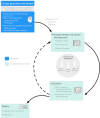iCanCope PostOp: User-Centered Design of a Smartphone-Based App for Self-Management of Postoperative Pain in Children and Adolescents
- PMID: 31008704
- PMCID: PMC6658275
- DOI: 10.2196/12028
iCanCope PostOp: User-Centered Design of a Smartphone-Based App for Self-Management of Postoperative Pain in Children and Adolescents
Abstract
Background: Moderate to severe postoperative pain in children is common. Increased pediatric day surgeries have shifted postoperative pain management predominantly to the home setting. Mobile health technology has the potential to overcome barriers to pain care by improving access to self-management resources. However, pain apps generally lack scientific evidence and are highly underutilized due to lack of involvement of end users in their development. Thus, an evidence-based pain self-management smartphone app that incorporates the needs and perspective of children and adolescents (end users) has potential to improve postoperative pain management.
Objective: This paper aimed to describe how the principles of user-centered design were applied to the development of iCanCope PostOp, a smartphone-based pain self-management app for children and adolescents after surgery. Specifically, it presents 2 completed phases of the user-centered design process (concept generation and ideation) for the iCanCope PostOp app.
Methods: Phase 1 was a multisite needs assessment from the perspective of 19 children and adolescents who had undergone various day surgeries, 19 parents, and 32 multidisciplinary health care providers. Children, adolescents, and parents completed individual semistructured interviews, and health care providers participated in focus groups. Data were summarized using qualitative content analysis. Phase 2 developed a pain care algorithm for the app using Delphi surveys and a 2-day in-person design workshop with 11 multidisciplinary pediatric postoperative pain experts and 2 people with lived experience with postoperative pain.
Results: Phase 1 identified self-management challenges to postoperative pain management and recovery; limited available resources and reliance on medications as a predominant postoperative pain management strategy; and shared responsibility of postoperative pain care by children and adolescents, parents, and health care providers. Key app functions of tracking pain, pain self-management strategies, and goal setting were identified as priorities. Phase 2 led to the successful and efficient generation of a complete preliminary pain care algorithm for the iCanCope PostOp app, including clinically relevant inputs for feasible assessment and reassessment of pain and function (rest or sleep, movement or play, and mood or worry), as well as a catalog of pain management advice to be pushed to end users (psychological, physical, pharmacological, and education).
Conclusions: The concept ideation and generation phases of the user-centered design approach were successfully completed for the iCanCope PostOp app. Next steps will include design finalization, app development (iOS or Android), evaluation through a randomized controlled trial, and subsequent implementation of the iCanCope PostOp app in clinical care.
Keywords: adolescent; mHealth; mobile applications; pain management; postoperative pain; self-management; smartphone.
©Kathryn A Birnie, Fiona Campbell, Cynthia Nguyen, Chitra Lalloo, Argerie Tsimicalis, Clyde Matava, Joseph Cafazzo, Jennifer Stinson. Originally published in JMIR Formative Research (http://formative.jmir.org), 22.04.2019.
Conflict of interest statement
Conflicts of Interest: None declared.
Figures
References
-
- Wright JG, Menaker RJ, Canadian Paediatric Surgical Wait Times Study Group Waiting for children's surgery in Canada: the Canadian Paediatric Surgical Wait Times project. Can Med Assoc J. 2011 Jun 14;183(9):E559–64. doi: 10.1503/cmaj.101530. http://www.cmaj.ca/cgi/pmidlookup?view=long&pmid=21543299 cmaj.101530 - DOI - PMC - PubMed
-
- Chou R, Gordon DB, de Leon-Casasola OA, Rosenberg JM, Bickler S, Brennan T, Carter T, Cassidy CL, Chittenden EH, Degenhardt E, Griffith S, Manworren R, McCarberg B, Montgomery R, Murphy J, Perkal MF, Suresh S, Sluka K, Strassels S, Thirlby R, Viscusi E, Walco GA, Warner L, Weisman SJ, Wu CL. Management of postoperative pain: a clinical practice guideline from the American pain society, the American society of regional anesthesia and pain medicine, and the American society of anesthesiologists' committee on regional anesthesia, Executive Committee, and Administrative Council. J Pain. 2016 Feb;17(2):131–57. doi: 10.1016/j.jpain.2015.12.008.S1526-5900(15)00995-5 - DOI - PubMed
-
- Shum S, Lim J, Page T, Lamb E, Gow J, Ansermino JM, Lauder G. An audit of pain management following pediatric day surgery at British Columbia Children's Hospital. Pain Res Manag. 2012;17(5):328–34. doi: 10.1155/2012/541751. http://europepmc.org/abstract/MED/23061083 - DOI - PMC - PubMed
LinkOut - more resources
Full Text Sources



